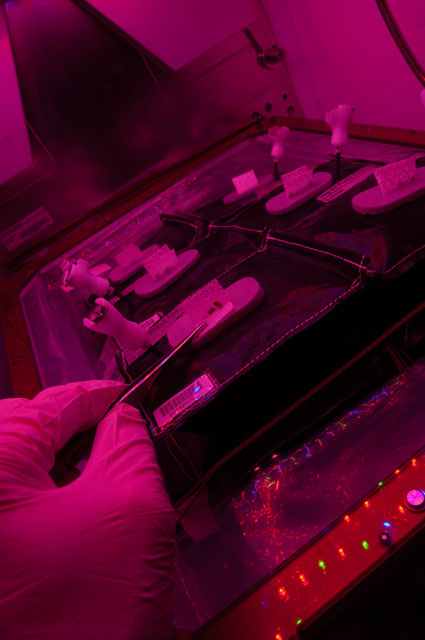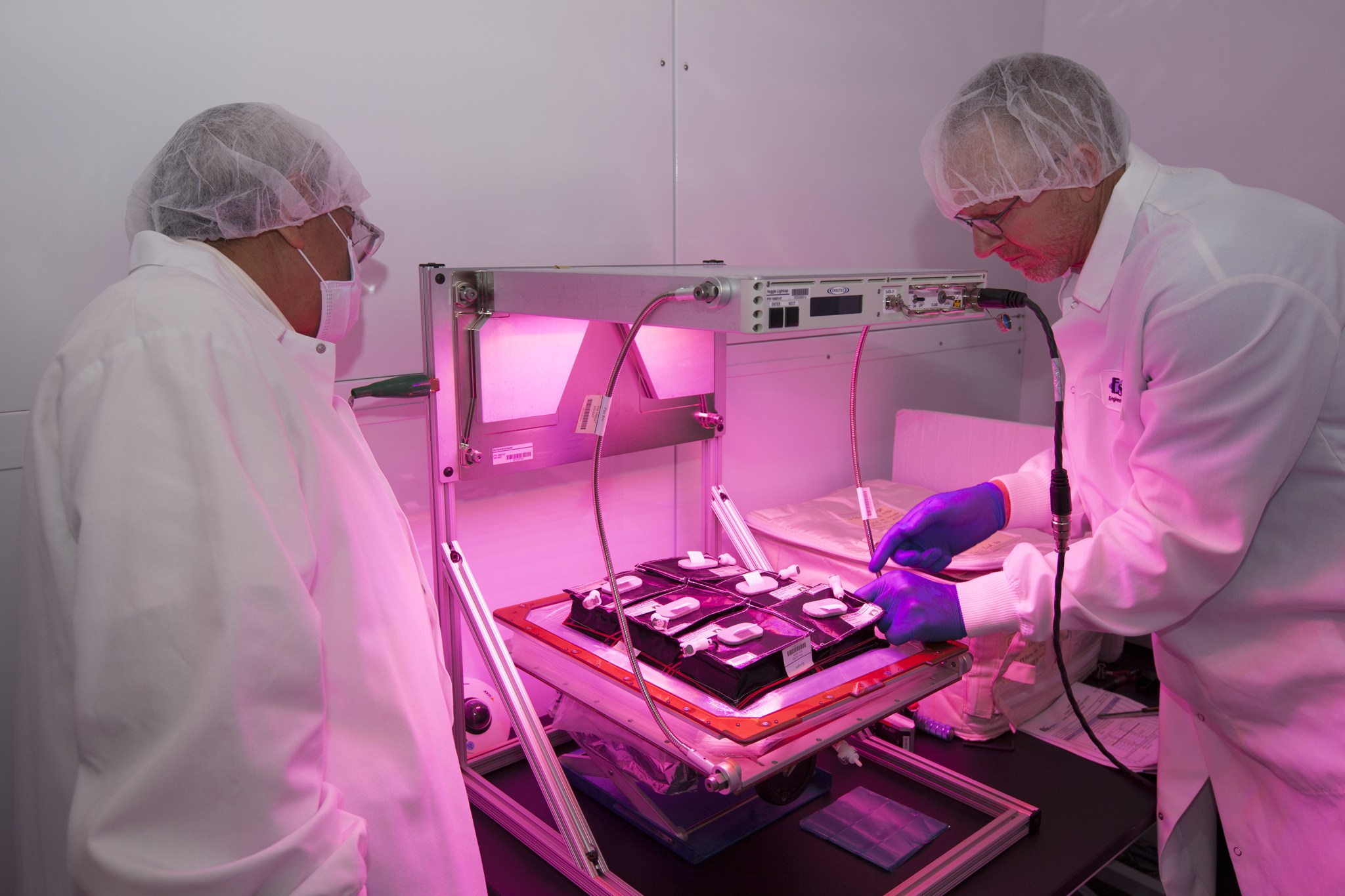If you plant it, will it grow—in microgravity on the International Space Station? Expedition 39 crew members soon will find out using a plant growth system called “Veggie” that was developed by Orbital Technologies Corp. (ORBITEC) in Madison, Wisconsin, and tested at NASA’s Kennedy Space Center in Florida.
The first fresh food production system, along with the Veg-01 experiment, were delivered to the space station on the SpaceX-3 mission from Cape Canaveral in April and transferred to the Columbus module for storage until it was time for in-orbit activation.
Expedition 39 flight engineers and NASA astronauts Steve Swanson and Rick Mastracchio installed Veggie in the Columbus module May 7 in an Expedite the Processing of Experiments to the Space Station (EXPRESS) rack.
Wearing sunglasses, Swanson activated the red, blue and green LED lights inside Veggie on May 8. A root mat and six plant “pillows,” each containing ‘Outredgeous’ red romaine lettuce seeds, were inserted into the chamber. The pillows received about 100 milliliters of water each to initiate plant growth. The clear, pleated bellows surrounding Veggie were expanded and attached to the top of the unit.
Inside each plant pillow is a growth media that includes controlled release fertilizer and a type of calcined clay used on baseball fields. This clay increases aeration and helps the growth of plants.
Dr. Gioia Massa is the NASA science team lead for Veggie. She sees Veggie and Veg-01 representing the initial steps toward the development of bioregenerative food production systems for the space station and long-duration exploration missions.
“The farther and longer humans go away from Earth, the greater the need to be able to grow plants for food, atmosphere recycling and psychological benefits,” Massa said. “I think that plant systems will become important components of any long-duration exploration scenario.”
About 24 hours after Veggie was activated on the space station, back on Earth, “pseudo-naut” researchers activated identical plant pillows in the Veggie control chamber in the International Space Station Environmental Simulator laboratory at Kennedy’s Space Station Processing Facility. Researchers will monitor the plant growth and perform the same procedures as Swanson is doing on the space station.
“My hopes are that Veggie will eventually enable the crew to regularly grow and consume fresh vegetables,” Massa said.
One of the plant experiment’s goals is to verify the Veggie hardware is working correctly. Another goal is to establish that the space lettuce is safe to eat.
On the space station, the Veg-01 plants will grow for 28 days. Photographs will be taken weekly, and water will be added periodically. The pillow wicks were opened to help the seedlings emerge. As the plants grow, the pillows will be thinned to one plant per pillow, and microbial samples will be taken to check for any microorganisms that may be growing on the plants. At the end of the cycle, the plants will be carefully harvested, frozen and stored for return on the SpaceX-4 mission later this year.
Veggie will remain on the station permanently and could become a research platform for other top-growing plant experiments. ORBITEC developed Veggie through a Small Business Innovative Research Program. NASA and ORBITEC engineers and collaborators at Kennedy worked to get the unit’s hardware flight-certified for use on the space station.
“Veggie could be used as a modular plant chamber for a variety of plants that grow up rather than in the ground,” said Gerard Newsham, the Veggie payload support specialist with Jacobs Technology on the Test and Operations Support Contract. “This is just the beginning.”
Another set of six plant pillows, containing ‘Profusion’ Zinnia seeds could be activated in Veggie for the Expedition crew to grow and enjoy as they wait for word that the red romaine lettuce is safe to eat. If the lettuce is safe to eat, Massa said an additional set of plant pillows containing the romaine lettuce seeds will be activated in Veggie.
“I hope that the astronauts on the space station eventually will use the equipment to ‘experiment’ with their own seeds or projects,” said Nicole Dufour, who coordinated and led the testing of the flight hardware at Kennedy and wrote the crew procedures for the astronauts to use on space station. “Veggie is designed for crew interaction and to enjoy the plants as they are growing.”
Dufour said she hopes Veggie serves as a regular facility the crew uses to grow food crops. Dufour is an engineer in the Flight Mechanisms and Flight Crew Systems Branch of the Engineering and Technology Directorate.
Brian Onate, former Veggie project manager, helped shepherd the plant growth system from initiating the build of the flight units in 2012 to just a couple of months before its delivery to the space station.
“I hope to see Veggie’s success as the first step in food production that will allow astronauts on the space station to enjoy fresh food and gain knowledge as we explore beyond low-Earth orbit,” Onate said.

























